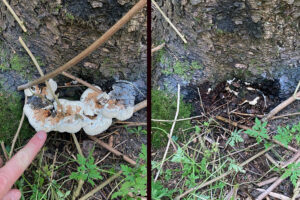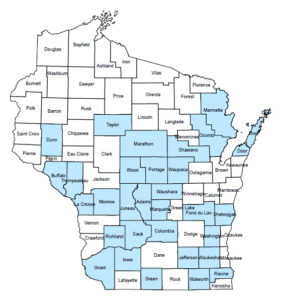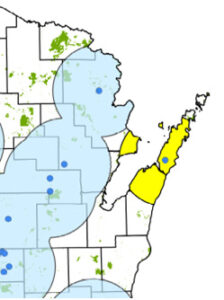
Two photos of the same spot on a tree in Door County, showing Heterobasidion root disease fruiting bodies (left) and the basal wound beneath them (right). / Photo Credits: Bill McNee, Wisconsin DNR
By Bill McNee, DNR Forest Health Specialist, Oshkosh;
Bill.McNee@wisconsin.gov or 920-360-0942
Heterobasidion root disease (HRD), formerly known as annosum root rot, was recently found in Door County for the first time.
In mid-September, several suspected HRD fruiting bodies were spotted in a white spruce plantation on privately owned land in the town of Sevastopol. One cluster of fruiting bodies located at the base of a dead spruce was confirmed as Heterobasidion irregulare, the fungal pathogen that causes HRD. The other fruiting bodies were identified as a native decay fungus that has a similar appearance.
The identity of the pathogen (H. irregulare) was confirmed through DNA sequencing. With these detections, HRD is now known to occur in 31 of Wisconsin’s 72 counties. This recent detection is the easternmost in the state. Previously, the most recent detections in new counties occurred in 2021 when the pathogen was found in Fond du Lac and Racine counties.

A map showing Wisconsin counties where Heterobasidion root disease (HRD) has been found as of October 2024, tinted in blue. / Map Credit: Wisconsin DNR
The Door County detection has resulted in an expansion of the 6-mile and 25-mile buffer zones surrounding known infections, used to apply risk-based, preventative stump treatments in the HRD Management Guidelines. These guidelines are used for forest management activities on state lands managed by Wisconsin Department of Natural Resources (DNR) and are recommended on other land ownerships.
Due to the time interval between timber sale preparation and harvesting the site, the guidelines incorporate a grace period following new detections of HRD. Users can choose between an existing map in the guidelines (updated each January) or the revised online map. The new grace period will expire in September 2025. Use of the most recent map is encouraged, when practical, to reduce the spread and impact of this disease.
Additional information about HRD, detection and buffer zone maps along with management advice is available on the DNR Forest Health webpage. The forest health program keeps records of all confirmed HRD detections. DNR forest health specialists should be contacted if HRD is suspected to be present in a stand.

A map of northeastern Wisconsin showing the 25-mile buffer for the new discovery in Door County (in yellow) and existing nearby buffer zones in light blue, with detection spots in dark blue. / Map Credit: Wisconsin DNR
